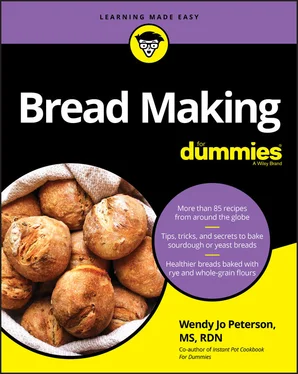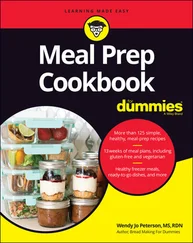 SPROUTING YOUR OWN GRAINS
SPROUTING YOUR OWN GRAINS
Sprouting grains is easy! Just follow these steps:
1 In a quart-size glass canning jar, place 1 cup of grains (like emmer, einkorn, or Khorasan).
2 Pour 12 ounces of filtered water over the grains.
3 Place a tea towel over the jar and place a rubber band over the tea towel to secure the towel as a lid for the jar.
4 Place the jar in a dark, cool cupboard and wait 24 hours; then drain and rinse the grains under cold, running water for 3 minutes.
5 Place the damp grains back in the jar; cover with the tea towel and use the rubber band to secure the tea towel.
6 Over the next two days, rinse the grains twice daily and return to the cupboard each time.
7 When you begin to see the grains sprout, transfer the grains to the refrigerator and use in salads, on sandwiches, or in baked goods.
Looking At Everything Else
Flour is, not surprisingly, a major part of bread making. But you can’t make bread with flour alone. Here are all the other ingredients that may go into your favorite bread:
Yeast: Yeast plays a major role in giving bread its rise (see Chapter 1for more on how yeast works). For bread making, yeast comes in two main varieties:Commercial yeasts: The most common commercial yeast used in the United States is active dry yeast. This yeast is activated with warm water (100 to 110 degrees) and then fed a little sugar to begin bubbling and release carbon dioxide. You can find active dry yeast in individual packages or in a glass jar. Store the yeast in a cool, dark, dry space.Wild yeasts: When you move into sourdough breads and work with a starter, you’ll discover wild yeasts. Wild yeasts are naturally occurring organisms in the fungus family that are floating around in the air, on our counters, on our skin, and in our flours. Wild yeasts are everywhere. By forming a starter, we are capturing and feeding the wild yeasts and creating a fermented yeast perfect for bread making. Be sure not to buy nutritional yeast! Nutritional yeast is deactivated, and it won’t help your baked goods rise.
Salt: Salt has an important role to play in bread making, from adding flavor to tightening the structure of gluten, and it helps slow fermentation. You can play around with different salts, like sea salt or kosher salt. If you use fancier salts, be sure they don’t have artificial coloring, or else they may cause discoloration in your dough.
Liquid: Liquids are responsible for rehydrating the flours and dissolving the yeast to help form the dough. Every bread recipe will have a liquid; however, varying liquids will create a different effect on the final product, from flavor to tenderness. Here are a couple liquids you may find:Water: Flour absorbs the water and helps to form the gluten. The steam released during baking helps the breads rise. You can use bottled, filtered, or tap water in the recipes in this book.Milk: Milk is a nutrient-dense liquid, with fats, sugar, and protein. The protein helps strengthen the dough, the fat helps tenderize it, and the sugars found naturally in milk feed the yeast. For the purposes of the recipes in this book, I used whole milk.Non-dairy milk: If you have a dairy allergy, you can play around with replacing cow’s milk with nutty alternatives, from almond milk to coconut milk. Non-dairy milks will naturally add their flavors and won’t provide the same protein strength, but they make for a decent substitute.
Eggs: Eggs impart a golden color to dough, as well as provide structure, tenderness, and richness. Think about a rich brioche bun, and you’ll understand the importance of eggs.
Fat: Fats can help soften the dough and create a tender crumb. Not every recipe calls for fat, and some fats impart a distinct flavor in the dough. Here are a couple popular fats used in bread making:Butter: Everything’s better with butter! Rich, cultured butter is my favorite, but because it’s harder to find, I’ve tested all the recipes in this book with unsalted butter. Butter provides tenderness to breads and actually softens the gluten. Getting the right balance of butter is important to create soft, but not crumbly, breads.Oils: A touch of oil on the surface of dough helps prevent the dough from drying out. Mixed in, oil tenderizes the bread.Bacon fat or lard: These types of fats are often seen in older recipes where people creatively used up rendered fat they had on hand. Bacon fat and lard provide flavor and tenderness to bread.
Fruits, nuts, or seeds: Not every bread recipe calls for fruits, nuts, or seeds, but they can give bread more nutrition and flavor. Fruits also provide sugars that feed the yeast. Nuts and seeds add in essential fats, crunch, and texture to the dough. Here’s what each of these ingredients brings to the table:Dried fruits: Dried cherries, apricots, raisins, currants, blueberries, and dates are great additions to dough. They don’t add to the structure, but these fun mix-ins do add texture. The sweetness of dried fruits also provides a substrate (food) for the yeasts to feed on and can create a sweeter-tasting bread.Nuts: The most commonly used nuts are walnuts, pecans, hazelnuts, and almonds. Nuts are better protected from high heat when mixed into the dough, instead of being sprinkled on the surface where they may burn at high heat. Nuts add great texture and a dose of nutrition in breads.Seeds: Flax, chia, sesame, and sunflower seeds are regularly enjoyed around the globe in breads. They add in nutrition and texture. Seeds can often handle higher heat than nuts. They may be best suited mixed into the dough and not just sprinkled on the surface. Seeds are nutrition powerhouses, packed with healthy fats and antioxidants. If you travel to Europe you’ll frequently see seeds and nuts added to breads. Store dried fruit, nuts, and seeds in an airtight container placed in a cool, dark pantry to extend their shelf life.
Honey, molasses, sugar, or dates: Whether you opt for honey, molasses, sugar, or pureed dates, you’ll get added sweetness, food for the yeast, and a touch of color through caramelization. If you opt to reduce or cut out sugar in a recipe, the crust may suffer in color. As a dietitian, I recognize that not everyone should have added sugars in their diet. So, if you prefer to substitute sugar, consider using a date puree, which provides fiber and essential nutrients like vitamins and minerals.
Chapter 3
Mastering Basic Bread-Making Techniques
IN THIS CHAPTER
 Walking through the steps to making bread
Walking through the steps to making bread
 Keeping your breads fresh
Keeping your breads fresh
Whether you’re using your hands or a stand mixer, making bread requires patience, strength, and skill. Many people assume that making bread is as simple as tossing together flour, water, yeast, and salt — and in some breads, it is that easy. But most yeast breads require more.
In this chapter, I explore the finite details of making a great bread. I also fill you in on how to store your bread so you can enjoy it for days (or even weeks!) to come.
Note: If you’re only interested in sourdough bread, turn to the next chapter for all the information you need.
Following Six Steps to Making Great Bread
Before you break out the bread pan to bake your first loaf, you need to understand the steps required to reach a great loaf of bread. Bread doesn’t lie: If you rush through or drag out these steps, your bread will show it.
Читать дальше

 SPROUTING YOUR OWN GRAINS
SPROUTING YOUR OWN GRAINS Walking through the steps to making bread
Walking through the steps to making bread










